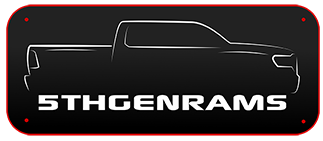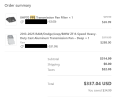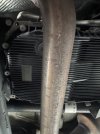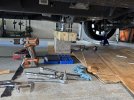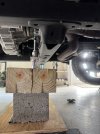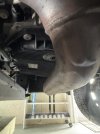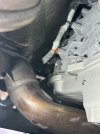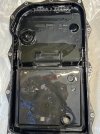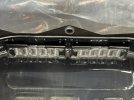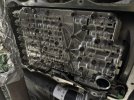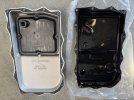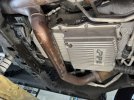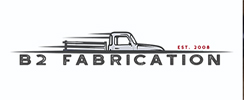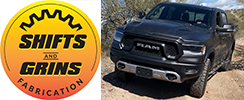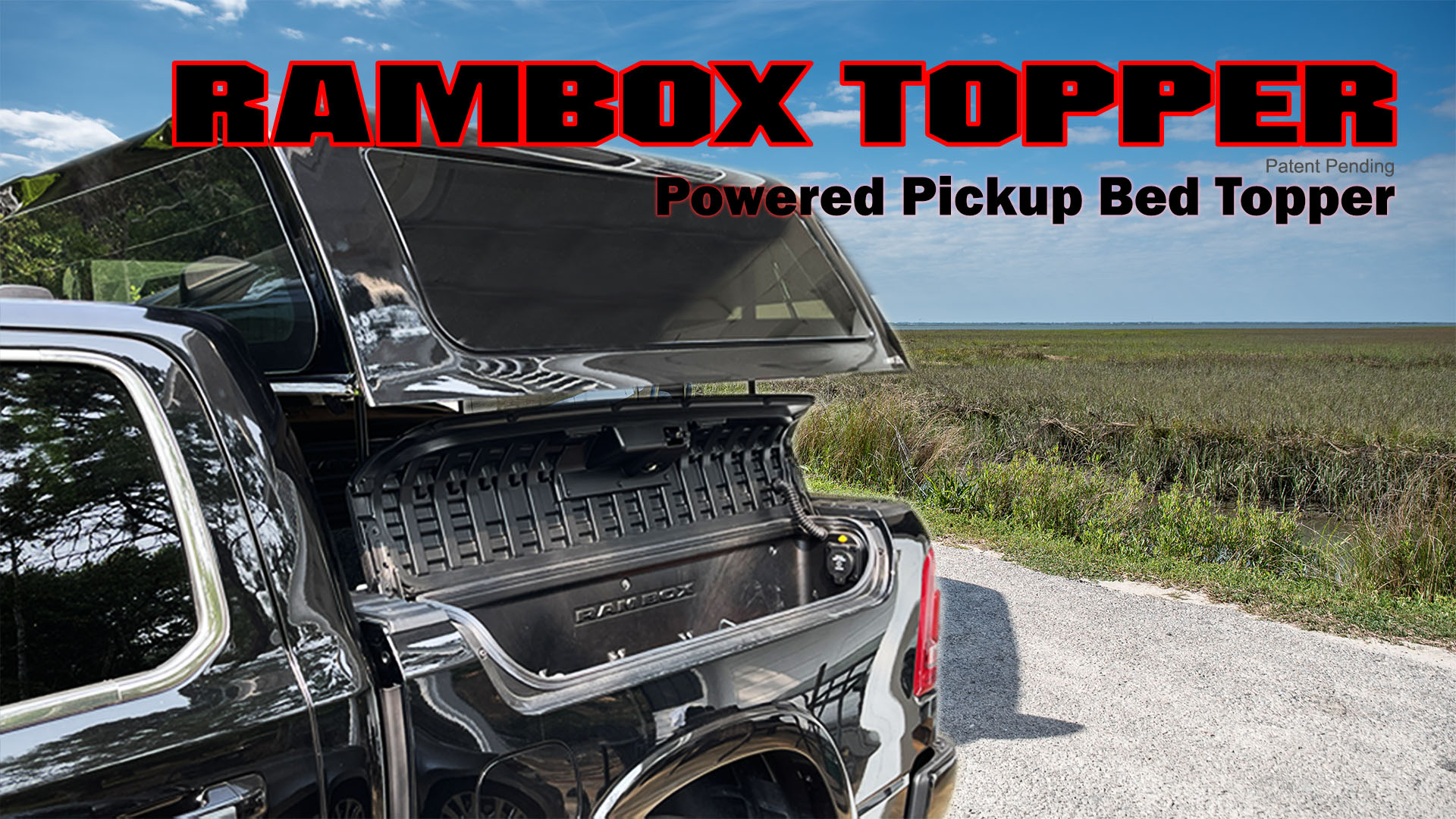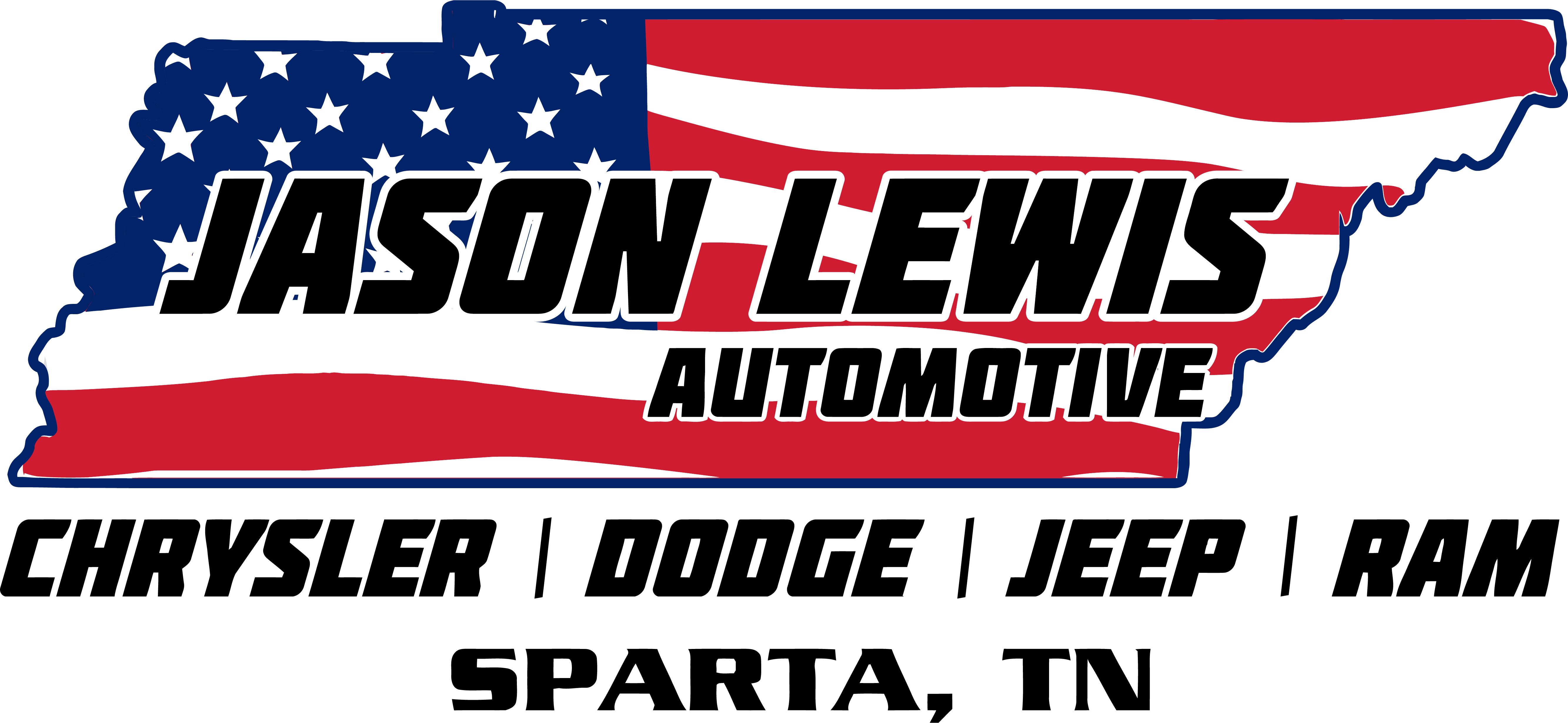I finally found some time to do the pan and fluid swap. For context, my truck is a 5.7 without e-torque. I realize the thread originated in the EcoDiesel-specific section, but this is the most consistent thread about the PPE pan that I could find on the site.
Prior to the pan swap and fluid change, I was having some hard shifting that was especially noticeable on low-speed downshifts. I was worried about the state of my transmission and it surviving the fluid change, but decided that if it was going to fail anyway I might as well have it fail now while I'm not having to drive long distances for work as much. F it, send it.
To get the truck in the air enough so that the transmission could be leveled and the rear tires were off the ground, I had to go max height on the rear jack stands (under the rear axle) and at the minimum height on the front (under the LCAs). This gave a wide enough stance that I felt confident in starting/running it during the air bleed and leveling part of the project. My garage floor slopes a bit more away from the house than I knew, and it became very noticeable when trying to get jack stands set just right...
Issue #1 came with not being able to access the fill or drain plugs due to the exhaust placement. I'd love to kick the engineer who routed this exhaust right in the shin. \
View attachment 204857
COMPLETELY blocked by the exhaust.
To get around these clearance issues, I unbolted the transmission from the crossmember and used a bottle jack (with a cinder block and 4x4s for height) to lift the rear of the transmission.
View attachment 204867View attachment 204858
This worked to both give a little bit of clearance for both the fill plug and the drain plug.
View attachment 204859
View attachment 204860
I was able to get the fill plug out using a 6" long reach 8mm hex socket and a 3" extension. If I had a normal 8mm hex socket that was 3/8" drive I probably could have fit it instead of going over the exhaust with extensions, but I only had a 1/2" drive. NOTE: FLUID WILL DRAIN FROM THE FILL PLUG AT THIS POINT. Have your drain pan ready underneath it.
The drain plug was not as easy. Since clearance still wasn't great working around the exhaust, I tried using a ball end long reach 10mm hex socket. This immediately rounded out the plastic drain plug. I jammed a T55 torx in there to try to salvage it but it only moved a few degrees before rounding out further. Eff it. I ended up drilling a hole in the lowest part of the transmission pan instead to let the fluid drain. 4.5 Quarts of transmission fluid drained from the transmission. Overall the fluid looked pretty damn good considering it had 110k miles on it and towed boats regularly up to 8,500 lbs.
The rest of the pan removal was completely drama-free. All of the T40 bolts holding the pan in place came out easily. I tried putting some foil over the exhaust to keep the fluid off of it but it didn't work as I had hoped.
View attachment 204862View attachment 204863
View attachment 204865
The old pan's bolt hole inserts popped easily out with a quick tap of a screwdriver on each. I installed the new Mopar gasket on the pan, gave it and the filter o-ring a healthy coating of fresh fluid, and bolted the new pan in place using the inserts from the original. I know it's debatable whether these are useful or not, but the instructions call for them to be reused so I did.
I first started with just two opposing finger-tight bolts holding it in place, added the rest of the bolts finger tight, then torqued them in the order shown on the instruction sheet. Torque spec shows 8-10 ft-lb, so they were torqued to 8 ft-lb to start. I later went back and checked the torque at 9 ft-lb after heat cycling the engine and all but three clicked immediately.
View attachment 204868
View attachment 204869
I left the bottle jack elevating the rear of the transmission during the entire fill process, as the transmission sits at a fairly steep angle even when the truck itself is level. I went as far as to put a bubble level on the transmission and got it close enough that the bubble was between the lines but almost touching one.
Fill process:
I used ZF Lifeguard 8 fluid for the fill, as it's what the transmission comes filled with from the factory. It's a bit harder to find, but is exactly the same as the Mopar-branded fluid for a much easier to stomach price. I pumped 5.5 quarts of fluid into the transmission before there was a steady stream coming out of the fill plug. I went through the shift cycle shown in the
Blauparts YouTube Video, which was a huge help in visualizing the steps of the process. The process is as follows:
1. With the truck still elevated and level, start the engine and let it idle
2.
Disable traction control
3. Immediately remove the fill plug and continue adding fluid until there is a steady stream of fluid from the fill port Reinstall fill plug hand-tight
4. With the truck still elevated and wheels off the ground, shift into reverse for 5 seconds while continuing to hold the brake
5. Continue holding the brake, shift to neutral for a moment, and then into drive for 5 seconds
6. Release the brake pedal and gently accelerate, allowing the transmission to shift into 2nd gear. Continue in 2nd gear for 5 seconds.
7. Release the accelerator pedal, gently apply the brakes, and shift into neutral.
8. In neutral, bring the engine up to 2000 rpm for 5 seconds, then release the accelerator and let it come back to idle
9. Shift into Park. The air has been effectively purged from the transmission.
10. Check that the transmission temp is between 86°F and 100°F. If it's above 100°F, shut off the truck and let it cool, as the transmission cannot exceed 120°F at any point during the process.
11. Remove fill plug and allow excess fluid to drain. The steady stream of fluid should slow to a light trickle between 86°F and 122°F, and that is the point that the fluid level is correct.
I had to add fluid both times while the engine was running and my transmission never went above 110°F. The truck took 8.5 quarts total with the +2 quart capacity pan, and I think that may be a bit low. I'm going to check and top it off in 1-2k miles.
During the test drive I couldn't believe how quietly and smoothly the truck shifted. It was absolutely a night and day difference with fresh fluid. I'm hopeful that the extra capacity will keep the transmission temps lower when towing heavier boats, and the new drain plug location will make future fluid/filter changes a lot easier than the initial pan swap project.
